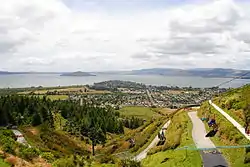Ngongotahā Valley
Ngongotahā Valley is a valley formed by the Ngongotahā Stream west of Rotorua, in New Zealand. Springs on the stream were landscaped in 1939 and promoted as Paradise Valley Springs, and the main road into the valley is Paradise Valley Road.[1] Mount Ngongotahā has a peak at 757 metres.[2] A gondala / luge ride operates on the side of the mountain.[3] The springs are still operating, and now include a wildlife park.[4]
Ngongotahā Valley | |
|---|---|
Rural locality | |
 Chairlifts and gondolas ascending Mount Ngongotahā | |

| |
| Coordinates: 38.123°S 176.145°E | |
| Country | New Zealand |
| Region | Bay of Plenty |
| Territorial authority | Rotorua Lakes |
| Population (2018) | |
| • Total | 1,590 |
| Postcode(s) | 3072 |
The stream is prone to flooding[5][6] but a joint project by the Bay of Plenty Regional Council and Rotorua Lakes Council to reduce the risk of future floods is ongoing.[7]
Demographics
| Year | Pop. | ±% p.a. |
|---|---|---|
| 2006 | 1,464 | — |
| 2013 | 1,410 | −0.54% |
| 2018 | 1,590 | +2.43% |
| Source: [8] | ||
The statistical area of Ngongotahā Valley, which at 178 square kilometres is larger than the valley and also includes Mamaku, had a population of 1,590 at the 2018 New Zealand census, an increase of 180 people (12.8%) since the 2013 census, and an increase of 126 people (8.6%) since the 2006 census. There were 540 households. There were 795 males and 795 females, giving a sex ratio of 1.0 males per female. The median age was 39.6 years (compared with 37.4 years nationally), with 363 people (22.8%) aged under 15 years, 267 (16.8%) aged 15 to 29, 753 (47.4%) aged 30 to 64, and 207 (13.0%) aged 65 or older.
Ethnicities were 81.1% European/Pākehā, 31.1% Māori, 2.3% Pacific peoples, 2.6% Asian, and 1.9% other ethnicities (totals add to more than 100% since people could identify with multiple ethnicities).
The proportion of people born overseas was 10.9%, compared with 27.1% nationally.
Although some people objected to giving their religion, 58.7% had no religion, 28.5% were Christian, 0.2% were Buddhist and 3.4% had other religions.
Of those at least 15 years old, 138 (11.2%) people had a bachelor or higher degree, and 291 (23.7%) people had no formal qualifications. The median income was $28,100, compared with $31,800 nationally. The employment status of those at least 15 was that 618 (50.4%) people were employed full-time, 198 (16.1%) were part-time, and 57 (4.6%) were unemployed.[8]
References
- McKinnon, Malcolm (25 May 2015). "'Volcanic Plateau places - Ngongotahā and district". Te Ara: The Encyclopedia of New Zealand.
- "Mount Ngongotahā Reserve". NZ Topo Map.
- Martin, Matthew (9 March 2015). "Skyline Rotorua celebrates 30 years". Rotorua Daily Post.
- "Paradise Valley Springs, Rotorua". Rotorua Travel Secrets. Retrieved 14 December 2020.
- "Rotorua's Paradise Valley". Landcare Research. Retrieved 14 December 2020.
- Piddock, Gerald (30 April 2018). "Ngongotahā Valley farmers rescued after rescue attempt goes wrong". Stuff.
- "Ngongotahā Flood Review Project". Rotorua Lakes Council. 14 December 2020.
- "Statistical area 1 dataset for 2018 Census". Statistics New Zealand. March 2020. Ngongotaha Valley (197900). 2018 Census place summary: Ngongotaha Valley